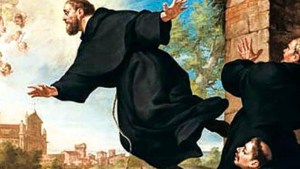Lenten Campaign 2025
This content is free of charge, as are all our articles.
Support us with a donation that is tax-deductible and enable us to continue to reach millions of readers.
The year was around 1005 at Malmesbury Abbey in Wiltshire, England. Suddenly, a man leapt from the highest tower… and managed to fly! At least that’s the contemporary account. Nobody had ever done it before. What would someone think at the time, seeing the sight? That it was a miracle? An apparition? Maybe they’d think it was related to the devil instead.
It was none of these things, but rather the project of a man with a dream. He wanted to imitate Daedalus and ascend to the skies as if he were a bird — which he reportedly managed with some (albeit brief) success.
The source for this story is a book called Anglorum Gesta Regum written at the end of the 11th century by the historian and monk William of Malmesbury. He is generally considered a reliable source, as incredible as the story of the flying monk may seem. The event is recounted more as an anecdote than as a central story, but is perhaps more interesting to contemporary readers than to the author himself.
The story of Brother Eilmer, the flying monk
This flying monk’s name was Br. Eilmer (although in some documents he appears as Elmer or even Oliver), a member of William of Malmesbury’s own monastery, although he was at least a generation or two older. His feat wasn’t a stroke of luck or a divine inspiration, but the fruit of hard work. We can only imagine how long he worked on the prototype of wings attached to his hands and feet before daring to leap into the void! He must have studied the wind, the appropriate materials to harness it, and more. If he was truly successful, it took a great deal of engineering work.
When the day finally came he climbed with his artifice to the abbey’s tower. We can imagine him testing the wind, looking at his notes, and at the perfect moment, jumping almost literally “on a wing and a prayer.”
William of Malmesbury recounts that everything went well for more than 200 yards. Then, however, the wind changed. Br. Eilmer panicked and, as he had no experience (no one in recorded history had ever flown before), he plunged to the ground.
Br. Eilmer broke both his legs and was lame for the rest of his life. He realized in hindsight that he should have made a tail for stability and steering… Unfortunately, now crippled, he never flew again.
Patron saint of flight?
Who knows what Br. Eilmer would have achieved if he hadn’t been badly injured in his first flight? Failure is not uncommon in science and engineering; the fact that he crashed doesn’t reflect poorly on his work. It is unfortunate, however, that Br. Eilmer was the subject of his own experiments and there were no safety measures nor any margin for error.
Although Br. Eilmer is remembered by William of Malmesbury as pious and god-fearing, “a man of good learning” and wisdom, he has not (yet) been recognized as a saint. That means he cannot be the patron saint of aviation, alas. That distinction is reserved for St. Joseph of Cupertino, who had the miraculous gift of levitation, and for Our Lady of Loreto.
Still, those of us who know that faith is not incompatible with scientific advancement can find inspiration in a monk who was simply 900 years ahead of his time.



